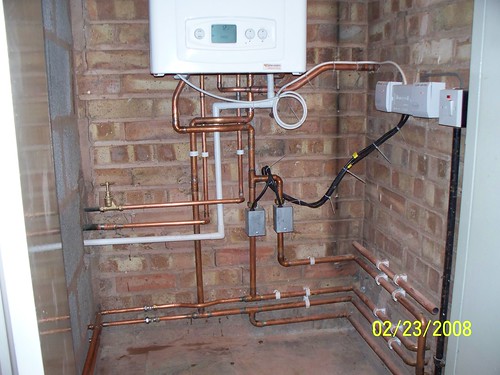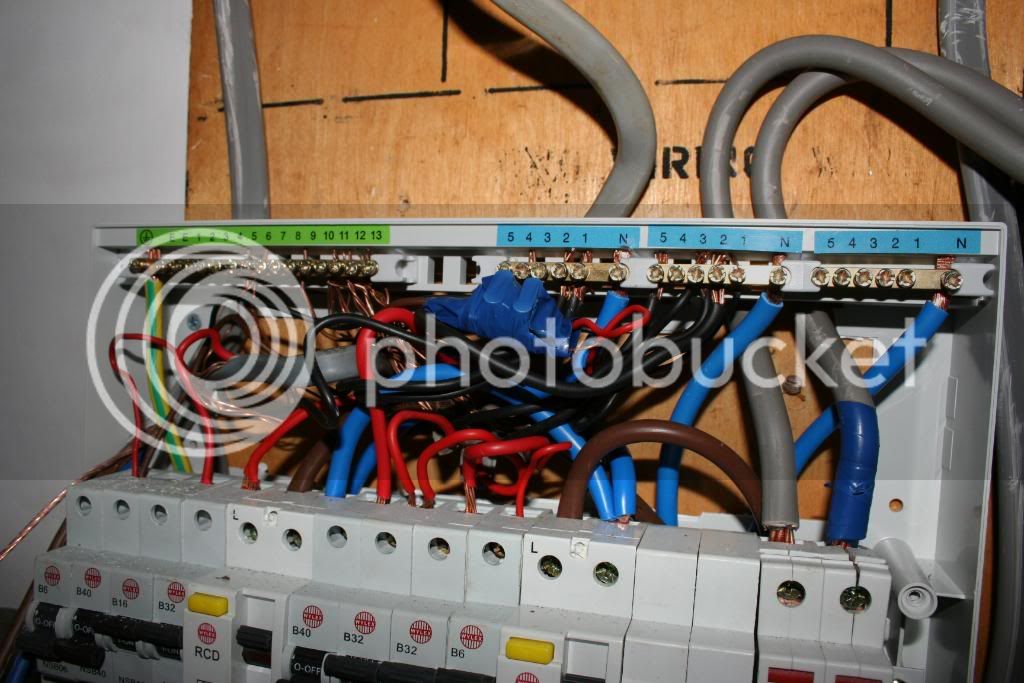Mid position motorised valve.
A domestic mid position motorised valve is a fairly simple device , using some very basic components. It utilises a small synchronous motor to energise the valve and a spring to pull it back when de-energised.
A syncron motor<www.syncron_motor.html> has a useful property, which helps the valve to fulfil it's function. That is, when fed with a Direct Current (see below for a fuller explanation), the motorized valve will stall in the position it was in when the DC is applied. and the spring cannot pull it back, since the motor is still energised, but not moving.
These valves usually have 5 wires, sometimes only 4 if the earth is missing. For the purposes of simplifying the diagrams, I am only going to show the live wires. This type of diagram is called a functional flow wiring diagram these are usually MUCH easier to follow. Neutral (blue) and earth (green/yellow) are implied. Manufacturers wiring diagrams , while often very good, usually make it difficult, if not impossible to understand what's going on, thus making fault finding difficult.
There are three Live connections to the motorised valve.
The white wire, which is energised by the external time and temperature controls, If white is live, the controls are calling for Central heating.
The gray wire, also energised by the external controls, only this time, when it is energised, it means we do not want hot water.
The orange wire, has a dual method of energising, as explained below, but for now, note that the external controls swap the grey and orange, if hot water is required, orange is live and gray is off, if hot water is not required, orange is off and gray is live
Now, you will see from this wiring diagram, that the orange wire is also connected to the boiler and pump, so when it is live, we can actually get the heat we are trying to control. From the wiring diagram above, you will see that this is fine when the controls are calling for hot water, but how does this get energised when we only want Central heating ? and if we do energise it, which obviously we have to, to get the boiler to come on, how come we don't get hot water as well ? Well read on.
Inside the motor box, is an arrangement of two change over micro switches, two resistors and a diode to convert the AC to DC, so we can stall the motor.
Note, we are only using one diode, so when the motorised valve is in the mid position, the current to the motor is not really DC<www.stalled-syncron-motor.html>, but rather, a modified AC, The wave looking something like this.
So the valve can be in three states, as follows:-
1. De-energised:- Where the spring pulls on the valve, closing off the Central heating port thus corresponding to a hot water only position, If the power is off, all the wires are dead, if the power is on, but we are not calling for hot water or central heating, the gray wire will be live, via the controls as above. When we are calling for hot water, then the controls energise the orange wire and de energise the gray, thus firing up the boiler and pump. Hot water from the boiler is pumped to the valve and as the HW port is open, it all goes to the calorifier in the HW cylinder.The motor will get a small current, through both resistors, but the two resistances combined are enough to ensure the motor does not turn.
2. Fully energised:- where the motor has wound up tight and closed off the hot water port, corresponding to the Central heating only position. It should be noted, that in this position, the motor is still energised with AC, but it is not turning, as it has stalled. This is usually very bad for an electric motor, try jamming the motor on your vacuum, and you will soon see smoke, as the motor tries to draw more power to turn. The Syncron motors in these valves , which only consume 6 watts of power at 240Volts, are designed to cope with this condition.
The control arrangement makes the White live, the gray live and the orange off. The orange wire is only temporarily off however. As the motor opens the valve and throw the switches, first, sw1 changes over, from the white to the gray, Following the wiring diagrams, you will see the motor still gets full power via the gray wire, and hence continues on, tripping sw2 thus energising the orange wire, via the white.
3. Mid position, the controls make the white and orange wires live and the gray off . If the valve is already closed (HW only ), then it the motor will be fed power initially via the white wire, when it switches sw1, Power comes via the white supply through SW2,, half rectified through the diode and reduced by R1 via the white wire, effectively stalling it at this mid point, corresponding to both heating and hot water. Again, it should be noted that this is normally a bad thing for an electric motor.and it is one reason why these motors burn out regularly. Note, that since the orange wire is live by the controls,
Note that the controls are supplying power to the orange wire, which is how the boiler and pump are energised. this power is fed through resistor r2. the value of which has bee chosen to minimise the magnetic stiction effect you get when a motor like this is fed DC. So the motor is actually being fed a modified AC Signal, enough to have a stalled motor, with minimal magnetic stiction.
Just to complete the explanation, the valve could have been in the Central Heating only position, when we called for both hot water and Central heating. From this position, both switches were already changed over and the motor was being fed full power via the gray wire through sw1. Now the controls have de-energised the gray, and energised the orange, so the motor looses power, and the spring will start to pull it back. Checking the internal wiring diagram again, you will see that since the orange wire is live, the motor is in fact being fed reduced power via the resistors r1+R2. this allows the motor to produce some force, which prevents the spring from pulling the valve back to the mid position too quickly and overshooting. When SW2 swaps over, the motor is again fed through the diode, stalling the valve in the mid position as explained above.







